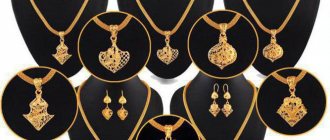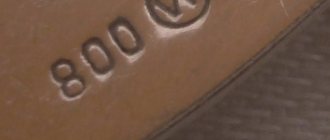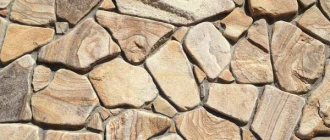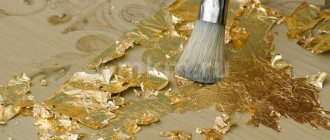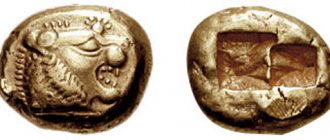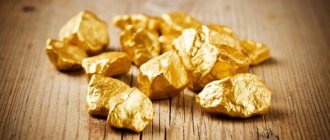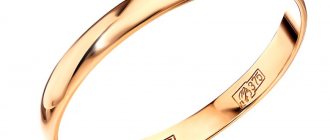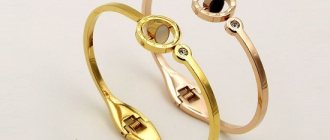Welcome to our page. We will talk about the ancient form of gold production and its place in human life. Modern society has gone far in changing priorities. The role of gold as an equivalent of value has changed, but it will never go into the category of lost. The metal that has been the cause of all the best and the worst throughout history continues to inspire interest and desire to own it.
Of all the types of gold, the most unusual for me is gold leaf. Its appearance is so ancient that when I see furniture with gilding, it immediately becomes an object of art, and not just a design for utilitarian purposes.
Susal - what does it mean: origin, definition of the word and its meaning
Gold leaf - what few people know, since its widespread use in the modern world began relatively recently. Metal is the thinnest sheets that can be used to coat different materials, creating a gilded effect.
The first mention of this material was discovered several thousand years ago in China. The popularity of this type of gold is due to its easy production. The metal's natural softness and malleability made it easy to cast into thin, continuous sheets.
Gold paper for decoration
Next, the ancient peoples of Egypt, India, and Greece learned about metal and its use. Already in the 10th century, tinsel began to be produced in Rus'. At that time, working with this type of gold was a separate craft, which was used in interior decoration, many household items, and architecture.
The name gold leaf comes from the ancient Russian word susal (translated as face), since such sheets were used to cover exclusively the front side of various objects.
Ancient secrets
If we talk about what options for gilding people resorted to in ancient times, then the methods were quite exotic in the eyes of a modern person inexperienced in this matter. For example, the indigenous people of America masterfully decorated products with gold plates long before this began to be done in more technically advanced Europe. To turn a copper object into gold, the Indians immersed it in a boiling solution of gold and potassium sulfate. They extracted the latter from salt lakes. After some time, the item acquired a gold layer and became indistinguishable from an item made entirely of real precious metal.
The Indian tribes had another interesting method of gilding. To do this, the master took a sheet of copper alloy with a small addition of gold and subjected this metal to heat treatment. Then he coated the sheet with a layer of copper oxide (which occurs in nature as a mineral called cuprite). From interaction with oxygen, the copper oxide oxidized, after which it was scraped off the sheet and forged again. As a result of repeating this procedure several times, the surface of the copper was enriched with gold. It is noteworthy that in this way the Indians turned inexpensive copper trinkets into valuables for two thousand years. So when the Spanish conquistadors took whole caravels of gold items looted from the Indians to the Old World, the big question is whether they were all real.
These days, the precious metal can even be found on your own dessert plate - as a decoration for a gourmet dish. Modern craftsmen often use it to decorate furniture made of wood and other materials. But in order to decorate objects with gold leaf with your own hands, you need special skill and knowledge, since this process is very labor-intensive.
Leaf sheets: type and thickness
Gold leaf, the composition of which varies only due to the ratio of the proportion of base metal to the proportion of impurities, can have several shades: pale yellow, white, reddish, orange, greenish. This variety is also achieved by adding small amounts of cadmium, palladium, and nickel. Gold leaf is very thin, its thickness does not exceed 0.5 microns. Most often, sheet material is used for finishing household products and paintings. Recently, it has begun to be used in the beauty industry and medicine.
Leaf sheets of different types
Alchemists
No one now questions the composition of gold, but it was once considered not only a constituent of minerals and a noble metal in its purified form, but also something that could be obtained from another substance. We are talking about alchemy, a science that appeared long before chemistry and became its ancestor. Alchemists were considered sorcerers and charlatans, they were distrusted and feared, but, nevertheless, there is no evidence that would allow us to say with certainty that this is pseudoscience or fiction. There are books on alchemy, eyewitness accounts, stories written into chronicles. Of course, gold has always been the greatest value and the idea of obtaining it through experiments has become a “fixe idea” for many generations of scientists.
Alchemists had a special vision of the world; they believed that in nature everything is one and everything evolves. This applied to the human soul, and to minerals and substances. Lead was considered the lowest metal, it was imperfect; gold was considered the highest, since it had exceptional properties. Many evidences indicate that alchemists found a secret compound that turned tin and mercury into the purest gold - the philosopher's stone. The composition and properties of this stone remained unknown, since those who invented it took the secret to the grave, and witnesses could only talk about the process of turning tin, mixed with powder or stone, into gold. Alchemical gold still excites minds to this day; the formula is unknown even now, despite the fact that our technologies are so developed. The only evidence in favor of the reliability of these experiments can be called experiments with uranium, when, under special influence, it forms completely different, new substances. History requires a respectful attitude, and remembering the grandiose structures erected before our era, long journeys and brilliant inventors, one can only shrug, suggesting that the alchemists of antiquity knew much more about metals than we do.
Gold in chemistry is just one element that has special properties, but its name in people's lives evokes completely different associations than other metals. It is a measure of wealth and success, symbolizing power and influence. Of course, at the very beginning of his acquaintance with this metal, a person was attracted by its beauty. The golden color was reminiscent of the Sun, which was deified by many peoples for many centuries. Gold became a material for religious buildings and decorations. Later, the first coins were issued from it, and the concept of money came into use. During the times of empires and kingdoms, gold was used in the decoration of utensils and premises. In churches it has always been used for frames, coverings, decorations; gold leaf has become widespread, and the domes of churches were covered with sheets. Nowadays gold is used both for aesthetic purposes and for science.
Gold leaf standards, composition: European and Russian, chemical formula
For the production of domestic and imported gold leaf, the same formula is used. But the standards and legal requirements for the manufacturing process differ, without which the product is not allowed to be sold.
The Russian standard is indicated by the symbols RS. The product is manufactured in accordance with GOST, which clearly states the composition, quantity of components and sample. The tinsel is in the form of books with 60 sheets.
A European product contains the EU mark, which indicates the foreign origin of the product. The law stipulates that precious books must have 25 sheets measuring 80x80mm.
The chemical formula remains the same regardless of the manufacturer. Leaf alloy includes the following components:
- gold;
- silver;
- copper;
- aluminum;
- zinc.
Manufacturing Standards
The production of gold leaf is actively carried out both abroad and in Russia. In the process of its production, companies adhere to certain standards established by law.
If a product does not meet established standards, it will not be suitable for sale.
All gold leaf that can be found on sale around the world is manufactured according to two standards: the Russian standard, also abbreviated as RS, and the European standard - EU marking.
Russian
When producing thin sheets of precious metal and other impurities, companies adhere to established GOST standards . It indicates which components must be included and in what quantities. The material standard is 960 standard.
Gold leaf is sold in book format , where each individual leaf is attached to special paper that preserves and protects it from damage. The book includes 60 square sheets, weighing only a few grams. Dimensions –91.5x91.5 millimeters. This format allows not only storage, but also safe transportation of products.
Coating composition by Russian standards:
- gold – 96%;
- silver and copper – 1% each;
- other components – 2%.
European
a product with an EU designation in a catalog or on a store shelf you are looking at a product that is manufactured in accordance with foreign requirements. European countries use a single standard, which is officially registered. Gold leaf books contain 25 sheets, the size of each plate is exactly 80x80 millimeters. These are the main characteristics of a European product, by which one can distinguish a domestic manufacturer from a foreign one.
Let's look at tinsel using the example of Noris brand products. This brand belongs to a well-known German company, which occupies a leading position among numerous manufacturers. Russian buyers also highly appreciated the quality of European goods.
The following products are widely used.
Pure palladium
The material is sold in a book of 25 sheets in a size that corresponds to the European standard (80x80 centimeters). The main advantage of the product is its polishability. It is also not afraid of corrosion. Disadvantage: sheets can only be used for interior decoration.
Coverage "Color card"
Thin sheets are bound together with papyrus paper . The buyer can choose the width independently. It varies from 3 to 110 millimeters. The material is used to cover similar surfaces. To purchase a “Color Card” you need to place an order.
Powder
To decorate embossed and structured surfaces, it is more convenient to use tinsel in the form of powder rather than sheets. The European manufacturer offers customers a product of 23 carats, fineness - 960. Buyers can choose between two packaging options - weighing 2 or 10 grams.
Experts recommend using this product only for gilding small objects.
Fake gold leaf
Leaf consists almost entirely of pure noble metal and the cost of such a coating is quite high. As a result, real expensive precious metals began to be replaced with cheaper analogues.
Application of gold leaf
Existing types of substitutes:
- Double - distinguished by a large amount of silver in the composition. Gold is layered on silver.
- Talma - a layer of leaf is layered on copper.
- Potal - this method allows you to imitate gold plating without adding precious metals. Copper and aluminum (sometimes copper and zinc) are used to make it. Additionally, it is necessary to use a layer of varnish to protect the coating from corrosive destruction.
- Mousse gold (tin sulfide) is a method of creating a gilding effect using metallic paint. This special alloy contains a mixture of sulfur and tin, without the addition of noble metals.
- Titanium nitride - allows you to make the gold-plated coating durable and well protected from external factors. Using nitrogen, you can slightly change the tone of the gilding.
- Gold-plated foil is used relatively recently. The composition contains copper, nickel and cobalt.
Features of leaf foil
The name of the material comes from the ancient Russian word “susal”, which translated into modern language means “face”. They covered the external (front) parts of objects, which gave them a particularly luxurious and rich look.
Not everyone knows what gold leaf is. The definition of its composition is as follows: these are the thinnest gold sheets with a thickness of 0.1 to 0.25 microns (1 micron = 0.001 mm). They are usually sold sewn into little books, the sheets of which are covered with the finest silk or tissue paper. You cannot handle these products with your hands, as they easily break and tear.
As a rule, 960 gold is used to make tinsel. But due to the low strength of the precious metal, it is often used in alloy with other materials. The composition of gold leaf may include:
- copper;
- silver;
- nickel;
- cadmium;
- zinc.
Depending on the additives, the material may have a red, yellow, green and white tint. There are two standards for making tinsel:
- Russian. The book measures 91.5 x 91.5 mm. It contains 60 pages separated by thin paper. Its weight is from 1 to 5.5 g.
- European. The book consists of 25 sheets measuring 80x80 mm.
There is another form of leaf leaf - fixed or transfer. The thinnest layers of gold are attached to wax paper and stitched into a book. The main feature of foil is its ability to adhere to any surface at the molecular level. Transfer gold is attached like stickers: the gold part is applied to the surface to be treated and pressed down. After some time, the silk paper is removed, and the gold remains on the surface. It is used to decorate smooth surfaces treated with a special adhesive.
Working with gold leaf in loose sheets is more difficult. They are peeled off from the paper with special tools, and then attached to the workpiece with a brush with natural bristles. This type of foil can be applied to objects of any shape.
How much gold leaf costs depends on its composition and type. Thus, the price of transfer foil is lower than that of free foil.
The process of making leaf sheets
To obtain tinsel sheets you need regular gold. The precious ingot is heated, shaped into a cylindrical shape, and then cut into small circles. Each piece obtained is a future leaf leaf. Each circle is separated from the other by a piece of paper.
The entire ingot cut into pieces is collected in a stack, which is placed under an automatic hammer. From the force of blows with a hammer, the pieces gradually turn into cakes of the required thickness. Based on the number of elements, the hammer can deliver up to 2 thousand blows. The resulting sheet is cut into a square shape, forming a book.
It is worth saying that for production of 20 sq.m. For tinsel, it is enough to use a little more than 1 gram of noble metal.
Cost of gold leaf
It is impossible to say exactly how much tinsel costs. Manufacturing plants set prices based on their own production and delivery costs. Initially, the price of pure gold is formed on the London Stock Exchange. The cost of alloys of other samples, for example 960, depends on this figure. And that means tinsel in any form.
Potal gold leaf
Imitation gold
It is clear that the use of gold leaf in many cases is too expensive. Firstly, gold itself is a rather expensive metal, secondly, its reserves are not endless, and thirdly, production technologies are complex. Therefore, for a long time people have been looking for ways to obtain beautiful decorative finishes, similar to gold, but at a much lower cost. The invention of gold leaf imitating gold leaf was not accidental; people came to it purposefully!
Currently, there are several technologies for producing gold leaf. According to one of them, instead of gold, other metals are used, such as aluminum, which are more common, cheaper and malleable, as well as metal alloys. The most common option is an alloy of copper and zinc. Once the alloys are applied to the piece, they are coated with a yellow varnish to imitate the tone of real gold. The second gold leaf technology involves the use of chemical compounds that are added to paints that imitate gold plating.
Gold leaf stamps
Manufacturers now offer a large selection of multi-purpose leaf coatings. Also, many foreign suppliers offer their products for ordering via the Internet with delivery to Lipetsk, Ufa, Minsk, Samara, St. Petersburg and other remote points of Russia.
German leaf coating Noris
One of the most famous producers of tinsel is the German company Noris. It supplies precious products to Russia and offers a wide selection for ordering through its online store.
Pure Palladium Noris
Pure palladium from the Noris company is produced in the form of a book of 25 pages measuring 80x80mm. This coating is easily polished and protects the surface from corrosive destruction, but is intended only for interior decoration. The price of such a product is up to 3 thousand rubles.
Areas of application of gold leaf
In the modern world, tinsel is still popular and is used in many areas of human activity:
- with its help, electrical circuits are covered: good electrical conductivity significantly extends the service life of many devices;
- gold is actively used by cosmetologists for anti-aging procedures;
- the precious metal is an officially recognized additive used in culinary masterpieces around the world;
- golden glitter is actively used in architecture, for processing three-dimensional objects;
- This coating allows you to focus on individual interior items.
Application of gold leaf
Restoration of icons and paintings
It has long been customary to use tinsel for finishing paintings, icons, and in painting. In this way the artist made his creation unique and luxurious. As a prime example, Leonardo Da Vinci used tinsel to cover his own paintings to protect them from dust, humidity and other damage.
Susal in cooking, food additive E175
Recently, it has become increasingly popular to use gold leaf in cooking. In many countries of the world it is a food additive, which is designated E175 on the packaging. Food with this ingredient is served by elite chefs in expensive restaurants around the world. Precious leaves are used to decorate cakes, sweets, desserts, ice cream, pastries, sushi and even meat dishes. Often tinsel is added to alcoholic, non-alcoholic drinks, and coffee. This supplement is edible and safe for consumption.
It has been proven that gold, when entering the human body, is not capable of causing harm and is excreted unchanged.
Cosmetology
In recent years, tinsel has become an integral part of cosmetic procedures and products. Experts are convinced that its chemical composition can have a certain effect on the epidermis, preserving the beauty and youth of the skin. Using sheets of leaf material, wraps are made for the face and other parts of the body. The procedure has gained popularity among people with various dermatological problems, since it is believed that gold, along with herbs and other components, can improve the condition of the skin in general.
History of gold
Gold got its name from its yellow color. In many languages, its name sounds different, but in one way or another it is associated with the designation of yellow, golden or greenish color. Gold has several key parameters. This is a noble metal, since it is not subject to corrosion and does not enter into oxidation reactions under the influence of the external environment. By the way, this is why it is successfully used in dentistry. Gold has a high density and this is what the system of its extraction is built on by washing silt, sand, and river water. Also, gold is very soft and ductile. Despite the properties of metal, it can be scratched even without the use of special equipment.
Gold was perhaps the first metal discovered by man. There are mentions of it in all surviving sources of antiquity; it was held in high esteem and was quite expensive. There is no doubt that interest in gold has never waned. It was valued for its beauty and special properties, only later realizing the value of its physical properties. Even before the chemical formula of the substance became known, buying gold was considered an excellent investment.
Special tools for manipulating gold sheets
Using gold sheets for domestic purposes is a rather complicated process that requires some skills and knowledge. Any thoughtless action can affect the outcome of the work. The first and main rule that is worth remembering is that the tinsel should not be touched with your hands. The thickness of the sheets is only a few microns, they tear and deteriorate extremely quickly. Special equipment must be used:
- a suede pillow - only on it you can carefully cut the sheets and peel off the gold from the paper;
- metal knife - a specialized tool with a special shape and an extremely sharp blade;
- lampenzel - is a special brush with a wide flat surface designed for carrying gold material;
- agate is a natural stone used for final polishing of the surface. It is used to produce specialized instruments with a smooth tip and handle.
Gold leaf
Modern production technologies
Today, leaf material is produced using electronic machines. The entire manufacturing cycle lasts up to 10 hours. Human participation is limited only to remote control of machines and machines.
The sheet is then rolled, cut into squares and flattened in a stack with a hammer to the thickness of regular paper. The metal sheets obtained in this way are covered with plastic and pressed again to the desired thickness.
Kinds
Leaf today can be in the form of free gold and stencil sheet. Screen tinsel is applied by craftsmen onto white silk paper. After gilding, the paper is removed. Free gold is applied to the surface with special squirrel hair brushes. Working with such material is very painstaking.
In the production of gold leaf, two types of standards are used. The material of the Russian standard is collected in a book of 300 sheets, the size of each sheet is 91.5 × 91.5 mm. It weighs 5 g. The European standard is designed for 25 sheets in a book. Sheet size 80×80 mm. Books may be of different types.
Rules for applying tinsel
The definition of tinsel itself suggests that the sheets are used for gilding surfaces. The whole process consists of the following stages:
- The surface is covered with gesso primer in 3 layers. The first layer is the thinnest, the rest are a little thicker. There should be at least an hour between each application. After applying the last layer, the surface must dry for more than 6 hours.
- The prepared surface is polished. Abrasive sheets are used for this.
- Next, the primer is covered with a layer of shellac, which is applied with a brush. Allow the layer to dry thoroughly.
- Sand the product again with paper using P600 abrasive.
- Next, you can proceed to the process of applying gilding. The tinsel is cut into pieces of the required sizes. The surface is wiped with a mixture of water and alcohol, onto which the sheets are actually glued. When the gold sticks tightly to the surface, it begins to be polished. In some cases, the water-alcohol solution is replaced with professional glue.
How surfaces are finished with gilding
Today, two methods of applying leaf sheets are used. Depending on the materials used and nuances in the technique, different results are obtained. Oil gilding consists of three stages:
- Applying oil glue to the sanded surface.
- Covering with tinsel (special tools are used).
- Applying a second layer of glue to secure the result.
This treatment produces matte gold plating. It is not afraid of moisture and does not crack during temperature fluctuations.
Glue gilding is more complex and closer to the work of ancient masters:
- Primer is applied to the polished surface in layers.
- Then the adhesive composition of the polyment is applied.
- Gesso, white primer for gilding.
- The process is completed by applying and processing tinsel.
A video of the filmed process will give a complete idea of what painstaking and beautiful work this is.
Rules for choosing gold leaf
Almost all manufacturers use the same technology to produce leaf material. The only difference is the surface area covered. To choose the right material for gilding, it is important to pay attention to the following points:
- Each manufacturer indicates for what purposes it is recommended to use tinsel. If it is intended for the food industry, it cannot be used for finishing work. Different materials are also used to cover smooth and rough surfaces.
- When decorating outdoors, it is better to choose a brand designed for outdoor use. This material is more resistant to weather conditions and better protects objects from corrosive destruction.
- It is best to give preference to well-known manufacturers who guarantee product quality. In addition, when purchasing large volumes, manufacturers always offer discounts to their customers.
Gold leaf in bottles
How it is produced
A piece of gold is taken and flattened on an anvil with a hammer, then this strip is cut into plates and, after several hours of forging with hammers of various sizes, it is pressed into a thin film, tens of times thinner than a human hair. To prevent the plate from sticking to the hammer and breaking, it is placed between two layers of “gear.” In Ancient Rus', it was made from beef liver chaff, or from animal intestines.
Now, of course, such methods are a rarity, and plastic is used to process gold leaf, and hammers have been replaced by computerized machines. The thickness of the sheet is regulated not only by the master, but also by the condition of its use in the future. On sale there are sheets of the same size 9.5x9.5 cm, but of different thicknesses. It depends on the weight of the gold leaf ligature. To make one and a half thousand sheets you need one hundred grams of alloy. Thin sheets are used in interior decoration - for gilding frames, icon cases and other objects. Thicker sheets, weighing three to five grams, are used for gilding domes, facade decoration and sculptures. For example, in Petrodvorets the Samson fountain is gilded with five gram gold leaf.
Reviews
Recently they covered old icons with gold leaf. We purchased 10 sheets of European products, which cost about 2 thousand rubles. Sheets measuring 80x80mm correspond to 23 carats. They are easy to work with and provide a durable protective coating for wood frames.
Genady R., Sevastopol
Nikolay L., Moscow
Having been involved in professional interior decoration, I can say that now it is much more profitable to use special paint, which creates the effect of natural gilding and is valued no less than precious tinsel. This coating performs the same functions, but costs significantly less. In addition, it is much easier to work with.
I have been practicing cosmetology for many years and gradually clients themselves began to become interested in procedures with gold. Then I learned about tinsel, which has a rejuvenating effect on the skin. I still don’t understand how it works, but I use procedures with gold leaves more and more often. Now I’m experimenting with products from different manufacturers, although so far they differ only in the cost of the sheets.
Liliya G., Moscow
Getting pure gold
Gold is almost never found in nature in its pure form. After many centuries of washing gold-bearing sand and ore, humanity has found a more effective way to isolate gold grains - amalgamation. This method requires elements that can react with gold and this element is mercury. It is added to the ore, combined with gold, and then removed and put to further work. Cyanide plating also works. Gold is precipitated from the resulting solution using zinc. Regeneration can also be carried out using an alkali solution.
In order to obtain a pure ingot or alloy with a controlled amount and composition of impurities, a number of procedures must be carried out. A set of such measures is called refining - purification of ore, scrap, alloy in order to obtain pure gold. Any particles of gold can be used as a material for work - parts of electrodes, elements of laboratory equipment, jewelry. There are several methods considered to be the most successful. The chemistry of gold settled on these methods, as they incur minimal losses of gold particles and spend less money on auxiliary materials.
Chemical refining is the separation of chemical elements from ore, gold-bearing natural chips or scrap of used products. It is multi-stage and includes a number of experiments that are aimed at identifying a valuable component. First of all, iron is excluded from the composition, since it does not allow the necessary operations to be carried out. It can be eliminated using a magnet, or using sulfuric or hydrochloric acid, which will dissolve its particles. The next stage requires the use of nitric acid, which dissolves many impurities traditionally associated with gold - copper, silver, zinc, tin. The gold remains in the precipitate, and table salt is used in the reaction. Next, the sediment containing gold and silver is treated with nitric and hydrochloric acid. After the necessary mixing, a series of heating and draining, a brown precipitate is obtained, which is thoroughly washed. After the final stage of purification, gold dust is obtained, which is smelted into an ingot. The purity of such gold can range from 99.95%.
The production uses an electrochemical cleaning method; in this case, pure raw materials are required, at least 900 standards, the purest gold for the procedure, as well as acids. There is also the Miller method, which is based on gaseous evaporation of impurities through the use of volatile chlorine. This method can be dangerous as poisonous gases can be released into the air.
